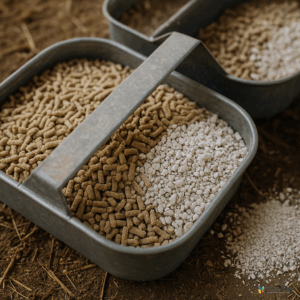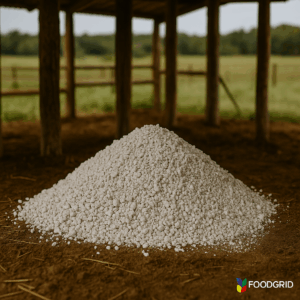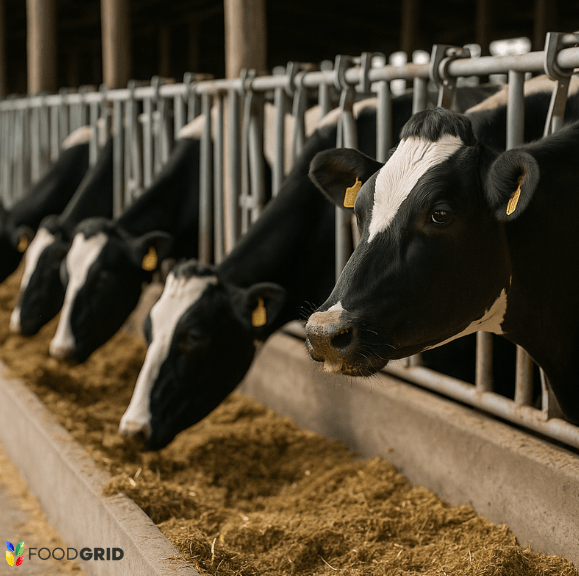For dairy producers, every gram of calcium counts. Poor calcium utilization doesn’t just waste money—it compromises skeletal strength, increases the risk of metabolic disorders like milk fever, and reduces overall herd performance. With feed costs rising and milk markets demanding compliance with additive regulations, dairy nutrition partners are under pressure to get calcium supplementation right.
Calcium salts—whether in carbonate, lactate, or advanced rumen-inert fatty acid forms—offer a proven path to improve mineral bioavailability, stabilize energy delivery, and safeguard long-term herd productivity. This guide provides a step-by-step, research-backed approach to incorporating calcium sources into dairy rations for maximum results.
Why Calcium Matters in Dairy Nutrition
High-yielding dairy cows require consistent calcium supply to sustain milk production and skeletal health. Calcium plays several critical roles:
Milk Production & Components: Calcium salts of fatty acids boost milk yield (+2–4 kg/day) and milk fat (+0.5–0.8%).
Skeletal Strength: Adequate calcium prevents bone loss and reduces the risk of downer cows.
Metabolic Stability: Calcium supports muscle contraction, nerve transmission, and prevents hypocalcemia during transition.
But calcium nutrition is more than simply meeting dietary percentages. The form, solubility, and timing of delivery dictate how efficiently cows absorb and utilize the mineral.
Forms of Calcium Sources in Dairy Feed
Calcium Carbonate
Widely available, cost-effective, and commonly used to prevent milk fever.
Granulated forms improve handling; micronized versions enhance solubility.
Calcium Lactate
More soluble than carbonate.
Suitable for situations requiring rapid absorption or specialized applications.
Calcium Salts of Fatty Acids
Rumen-protected, stable sources of energy and calcium.
Proven to enhance milk yield, fat content, and overall profitability.
Practical Considerations for Dairy Nutrition Partners
Calcium Solubility and Absorption
Challenge: Inconsistent absorption leads to metabolic imbalances in transition cows.
Solution: Use a mix of rumen-protected calcium salts (energy + mineral support) and carbonate forms for balance.
Particle Size and Flowability
Fine powders improve solubility but may cause dust issues.
Granulated or palletized forms reduce dust, improve handling, and ensure consistent mixing in TMR systems.
Balancing Calcium and Phosphorus
Excess calcium interferes with phosphorus absorption, leading to skeletal and metabolic issues.
Ideal Ca:P ratio: 1.5–2:1 in lactating cow diets.
Nutritionists should use digestibility coefficients, not just total mineral percentages, for precise balancing.
Regulatory Compliance
Export markets often require EU-approved calcium sources (E170).
Compliance ensures market access while preventing costly recalls.

Research-Backed Outcomes
- Eggshell Strength: Studies show that incorporating a mix of coarse and fine calcium carbonate increases shell thickness and reduces breakage by up to 20% (University of Georgia Extension).
- Bone Health: Granulated calcium sources improve tibia ash content, supporting skeletal resilience in high-lay hens (NRC, 1994).
- Feed Efficiency: High-solubility salts improve calcium retention, lowering excretion and environmental load (Iowa State Extension, 2019).
Common Challenges and Solutions
1. Brittle Eggshells
- Cause: Poor calcium source solubility or incorrect timing.
- Fix: Blend coarse and fine particle calcium sources; include soluble salts like lactate.
2. Dust in Premixes
- Cause: Use of micronized calcium carbonate.
- Fix: Switch to granulated forms or coat particles to improve flowability.
3. Phosphorus Interaction
- Cause: High dietary calcium suppresses phosphorus utilization.
- Fix: Balance Ca:P ratio carefully, and consider using phytase enzymes to liberate bound phosphorus.
4. High Waste and Excretion
- Cause: Low bioavailability of standard calcium carbonate.
- Fix: Adopt high-solubility sources like ReliaCal for better efficiency.
Economic ROI of Calcium Salt Optimization
- Eggshell Breakage: A 2% reduction in breakage can save $20,000–30,000 per year in a 100,000-hen operation.
- Bone Integrity: Reduced culling translates to longer productive cycles and lower replacement costs.
- Feed Efficiency: Higher bioavailability reduces waste minerals, cutting disposal and environmental costs.
On average, incorporating optimized calcium salts delivers a 3–5x return on investment, making it one of the most cost-effective interventions in poultry feed formulation.

Supplier and Sourcing Insights
Purchase Formats: Palletized or bulk totes (1-ton).
Global Suppliers: Trusted providers include Valudor and Megalac.
Buying Strategy: Partner with GMP+ certified suppliers for consistent quality, rumen stability, and compliance with EU (E170) standards.
Feeding Guidelines for Dairy Producers
Transition Cows: 100–150 g/day calcium salts of fatty acids for energy and mineral support.
Lactating Cows: 2–3% of DM as calcium salts for optimal yield and fat.
Dry Cows: Focus on DCAD diets with controlled calcium carbonate to minimize milk fever.
Monitoring Tip: Track milk yield, butterfat %, and incidence of metabolic disorders to evaluate supplementation success.
References
Internal Resources
For more insights on optimizing feed strategies, explore FoodGrid’s resources:
Are you ready to enhance eggshell quality, reduce waste, and strengthen flock performance with calcium salt solutions?
👉 Partner with FoodGrid for premium calcium additives designed for poultry feed efficiency and compliance.
Contact us today to discuss formulations, sourcing, and tender support.
